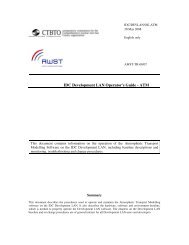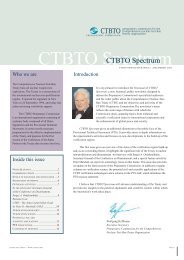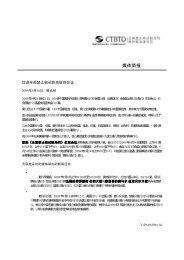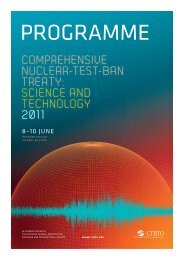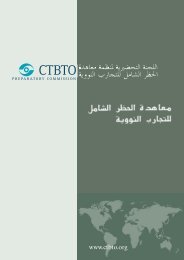ctbto Spectrum
ctbto Spectrum
ctbto Spectrum
Create successful ePaper yourself
Turn your PDF publications into a flip-book with our unique Google optimized e-Paper software.
PerspectivesThe Enduring Value of the Comprehensive Nuclear-Test-Ban Treatyand New Prospects for Entry Into Forceby Daryl G. KimballThe history of the nuclear age makes it clear thatopportunities to reduce the risks posed by nuclearweapons are often very fleeting. When the rightpolitical conditions are in place, governmentalleaders must seize the chance to make progress.In 1958 and again in 1963, U.S. and Sovietleaders attempted to negotiate a comprehensiveban on all nuclear test explosions. They cameclose but failed to seal the deal. While the lattereffort led to the 1963 Partial Test Ban Treaty, ittook another three decades of on-and-off effortsto conclude negotiations on a comprehensivetest ban treaty. During that time, hundreds moreunderground tests propelled further arms racingand proliferation.Treaty (NPT) regime. The nuclear weaponStates’ commitment to achieve the CTBTwas a crucial part of the bargain that won theindefinite extension of the NPT in 1995 andthe 2000 NPT Review Conference document.U.S. Senate’s untimely rejectionof the CTBT in 1999Over the years, the importance of theTreaty to global security has only increasedand international support has grown. Today,179 countries have signed the CTBT, and144 countries have ratified. Unfortunately,the U.S. Senate’s brief debate anduntimely rejection of the CTBT in OctoberThe situation is self-defeatingand counterproductive. Given the U.S.signature of the CTBT and its testmoratorium policy, the United Statesbears most CTBT-related responsibilities.Yet Washington’s failure to ratify hasdiminished its ability to prod other nationsto join the Treaty and refrain from testing.At the same time, there is no need—nor isthere any political support—for renewedU.S. testing for new nuclear warheads orfor any other reason.Treaty helps preventregional conflicts and avertnuclear arms race“The global norm against testing remainsstrong, for now. Yet the absence of CTBTentry into force also means that the fullrange of verification and monitoring tools,confidence building measures, and the optionof on-site inspections, are not available tohelp strengthen the international community’sability to detect, deter, and if necessaryrespond to possible nuclear testing.”The CTBT is also needed to help headoff and deescalate regional tensions.With no shortage of conflict and hostilityin the Middle East, ratification by Israel,Egypt, and Iran would reduce nuclearweapons-related security concernsand bring those States further into thenuclear non-proliferation mainstream.Action by Israel to ratify could putpressure on other States in the regionto do so. Iranian ratification would helpaddress concerns that its nuclear programcould be used to develop and deploydeliverable nuclear warheads.Today, the 1996 ComprehensiveNuclear-Test-Ban Treaty (CTBT) remainsa vital disarmament and non-proliferationinstrument. By prohibiting all nuclear testexplosions it impedes the ability of Statespossessing nuclear weapons to field new andmore deadly types of warheads, while alsohelping to prevent the emergence of newnuclear-armed States.Moving forward on the CTBT is also anessential step towards restoring confidencein the beleaguered Nuclear Non-Proliferation1999, coupled with the George W. Bushadministration’s opposition to the Treaty,has slowed the momentum. Nine key Statesmust still ratify to achieve entry into force.Partially in response to U.S policy onthe CTBT, some countries that have signedthe CTBT, such as China and Israel,have delayed their ratification processes.Others, including India and Pakistan, haveyet to sign the Treaty and are unlikely todo so unless the United States, China, andperhaps other hold-outs, finally ratify.Likewise, North Korean accessionto the CTBT would help demonstratethe seriousness of its commitment toverifiably dismantle its nuclear weaponsprogram through the Six-Party process 1 .The ongoing India-Pakistan nuclear armsrace could be substantially slowed to thebenefit of both countries if they signed1The Six-Party talks process aims to find a peacefulresolution to security concerns raised by theNorth Korean nuclear weapons programme. Theprocess began in response to Democratic People’sRepublic of Korea’s (DPRK) withdrawal from theNPT in 2003 and involve China, the Republic ofKorea (South Korea), DPRK, the United States,the Russian Federation and Japan.pa g e 1 2 C T B T O S p e c t r u m 1 1 | S e p t e m b e r 2 0 0 8



